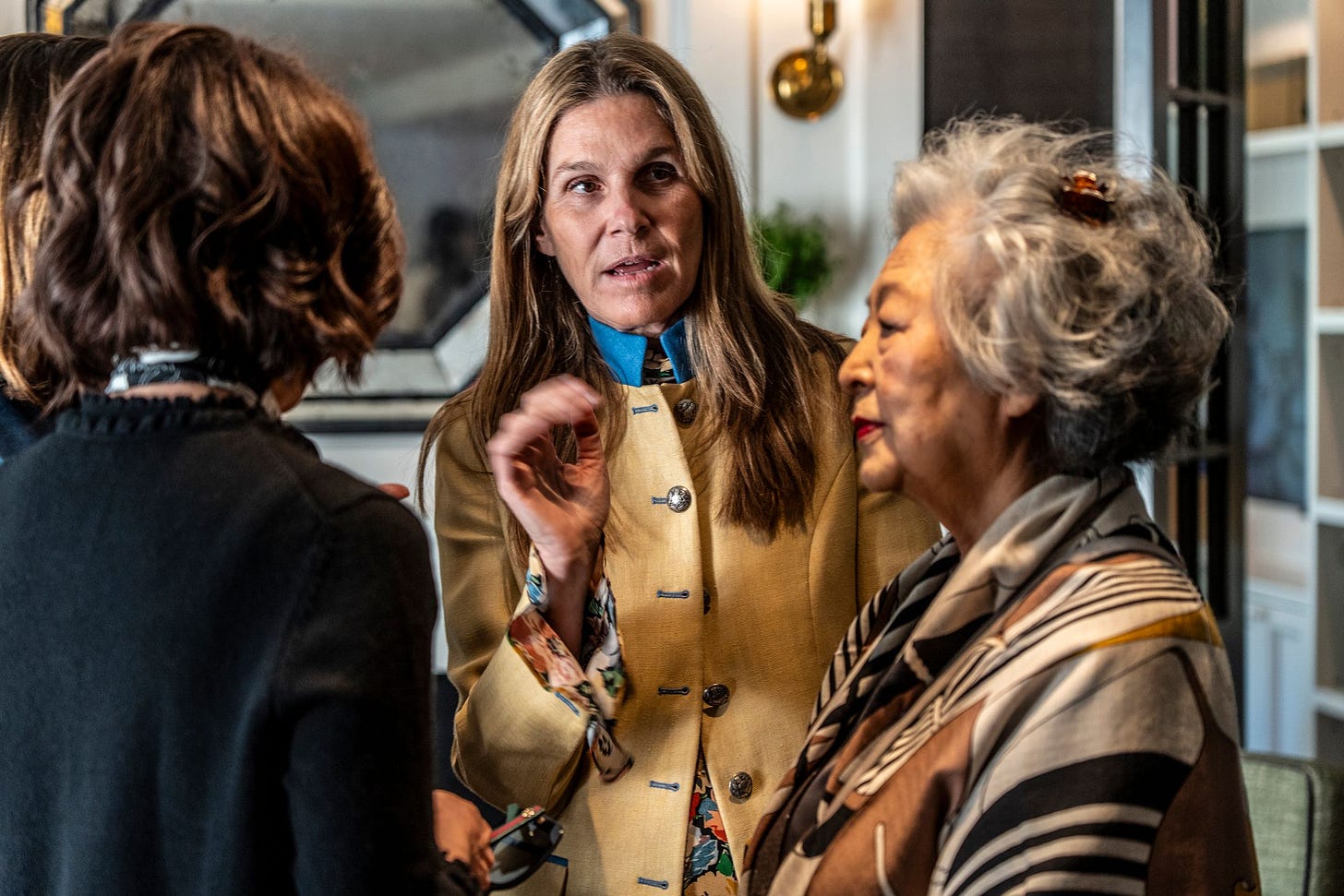As we wait for election news, distract yourself with treats: a new essay about dating from the extraordinary Candace Bushnell! And an interview with Joyce Maynard about her deeply satisfying novel, perfect for the beach. —Emily Gould
EARLY AND OFTEN
Getting Those Endorsements in Under the Wire
Eric Adams endorses NYC tap water! Emrata endorses Zohran! Things of that nature.

Today has insane vibes. It’s fry-an-egg-on-the-pavement hot out, except the egg might sort of steam-fry because it’s also humid. We’re all on edge waiting for election results (which we probably won’t get anytime soon). Here are some last-ditch wild things happening among the various campaigns!
Eric Adams made an ad for drinking water.
Emily Ratajkowski endorsed Zohran Mamdani, “which is also a thing her Too Much character would do” – Vulture critic Jackson McHenry
Brad Lander and Mamdani hit The Late Show With Stephen Colbert. He didn’t endorse either one of them, they endorsed each other, it was cute.
This Andrew Cuomo fan was excited to meet Zohran.
Stavvy endorsed Zohran. All the podcasters endorsed Zohran.
Archival find of the day: In 2002, 11-year-old Zohran made an appearance in our holiday gifts issue.
SEX AND THE BEACH
What Candace Bushnell Gleaned From 50 Years of Dating
In the Hamptons, it’s all about Mr. Bigger or Mr. Biggest.
In a new essay that’s as no-holds-barred as the iconic New York Observer columns that gave us Sex and the City, doyenne of dating Bushnell reveals the adventures she and her friends have had with the deep-pocketed boomer men who summer out East.
“What are you doing here?” I asked, despite knowing the answer: He wanted to get his wienie waxed. He’s a standard male, and I’m a female who had come into his vicinity via the date, and he was going to double-check, or attempt to convince me, or emotionally con me into meeting his sexual needs. The worst thing that could happen is I’d say “no.” The best thing? A “yes” and then he wins.
BOOK GOSSIP
Joyce Maynard’s How the Light Gets In Is a Perfect Beach Book
We chatted about the extraordinary circumstances under which she wrote it!
Newly out in paperback, generation-defining novelist and memoirist Joyce Maynard’s latest book has everything you want in a summer read. It’s long enough to last you through a week of vacation, it’s about a complicated family and all the highs and lows of the human condition, and there’s a hot romantic story line too. I jumped at the chance to get on the phone with Maynard, whom I’ve felt a kinship with for years: We’re in an elite sisterhood of women who had our young lives … let’s just say shaped … by having our essays, accompanied by wide-eyed portraits, on the cover of The New York Times Magazine. “An 18-Year-Old Looks Back on Life” was published in 1972. Since then, Maynard has published 13 novels and five memoirs, including At Home in the World, which caused a literary scandal when it was published in 1998 because of its depiction of her relationship with reclusive author J.D. Salinger, which took place when Maynard was a teen. Her 1992 novel To Die For was the basis of the classic Nicole Kidman movie. She now runs a hotel in Guatemala, where she regularly hosts memoir-writing retreats for women. When we spoke, she was on a camping trip in North Dakota with her boyfriend.
How the Light Gets In and its precursor Count the Ways are both about a family living on a farm in New Hampshire — matriarch Eleanor, who’s the point-of-view character, father Cam, and children Alison (later Al), Ursula, and Toby. A lot happens in this family’s life. You relate their story in very short chapters, just the moments that shape their existence most. How did you come to write that way?
During the first six months of the pandemic, I was staying in a small village in Guatemala. I had invited two young women to do a writing workshop, and they had no particular reason to return back to the States. They were both in their very early 30s. I invited them to stay with me, and I thought that we would be there for a few weeks. We stayed for six months. And that book that I was writing, Count the Ways, which was the precursor to How the Light Gets In, was really transformed by the presence of the young women to whom I read a chapter that I'd written every night. When I finished it, they said, “Well, you have to start another book because we love having these reading times.” It was like their bedtime story.
Eleanor experiences some heartbreaking tragedies. First, Toby almost drowns at age 4 and is left with a brain injury. Then Cam cheats on her with their teenage babysitter, prompting their divorce. And much later on, she suffers an estrangement from her daughter Ursula. That, to me, was the most moving part of the book. How did you write that relationship so vividly? Also, just tell me if you’re estranged from your daughter in real life!
In terms of the estrangement from Ursula, I do know some things about that. All my children, I think, love me, though. I also feel an obligation as a person who speaks about the experiences of women to talk about things that many women can't talk about, which obviously I did to some rather painful results — but I don't regret them — when I published At Home in the World. I'm not cut out of the life of any of my children, but I certainly have had some very painful experiences that way. And a lot of people who do experience estrangement do so in great isolation and shame and guilt. And in the last ten years, I've come to know about 60 such women. To me, that's an epidemic, and it's an epidemic that we don't hear a great deal about. It’s sad for both sides.
You’ve lived on a farm in New Hampshire. You got a divorce at age 35. You have three children. None are brain-injured or transgender. One plays a Marvel villain. There’s a lot of you in these books, but they’re also very thoroughly fictional. How do you pull that off?
My characters, in whatever form they take — I guess I would exclude To Die For here; she's not a family person. But if you sat down and read all my books in a row, which I won't recommend, you would know a thing or two about me. You would know that I love Dolly Parton and that I like to skate and that I'm a good cook and that I'm a little obsessive about protecting children from pain. And you would know that family is an obsession and no doubt that the origins of that one come from the absence of family in my own life growing up. Yeah, they're all stories. Some are true, some contain truth. And I hope the characters always feel so real. I love it that you thought that I was estranged from my daughter based on that novel because then I've done my job that I've made a character who feels really believable.
Click Your Way Out
“Nearby, someone’s toddler doodles with a crayon in between bites of caviar.” Seen and heard at East Hampton’s hottest new restaurant, Swifty’s.
Please stop me before I justify buying a sweater on a 100-degree day because it’s 40 percent off (of $615). (But look how perfect it is!!) (Okay, I didn’t buy it, but I did save it for later with the Strategist’s handy new tool for doing that.)
What’s going on with John Fetterman’s memoir that’s being ghostwritten by Buzz Bissinger? (You’ll need a Defector subscription to find out … possibly worth it.)
So Ali Hazelwood, whose “baby’s first omegaverse” novel The Bride was a megahit, has a new book out, Problematic Summer Romance. But she’s just been chased off social media by a ravening horde for [checks notes] saying she prefers Gale to Peeta in The Hunger Games? Fandom people are deeply unwell.
If you put an ice cube (just fish it out of your iced coffee) on your pulse points — neck, wrist, inner elbow, groin if you’re in private — you’ll feel instantly cooler. The more you know!








Thank you for these just in time recommendations. I’m consuming the Bushnell candy now and just borrowed three of Maynard’s from Libby. And I’m about to take a cold bath.
How nice 👍, yes is 92 plus here in the Midwest. Have fun 🤩 .